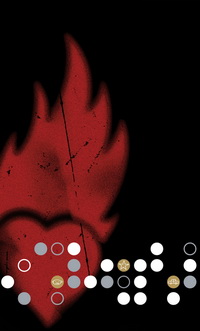Home » Jazz Articles » Book Review » Stealing Hearts At A Travelling Show: The Graphic Design of "U2"
Stealing Hearts At A Travelling Show: The Graphic Design of "U2"
 Stealing Hearts At A Travelling Show: The Graphic Design of "U2"
Stealing Hearts At A Travelling Show: The Graphic Design of "U2" Lisa Godson
106 Pages
ISBN: 0954519302
AMP Visual
2003
Since its humble beginnings in the 1960s, the album cover has travelled a long distance from being a practical protective packaging to a miniature canvas rife with famous and iconic images. Every music collector or fan knows that whatever the media—be it vinyl, cassette or CD—the ears also have eyes. As a form of youth culture, popular music was always intimately entwined with the visuals of that culture. From The Beatles' Sgt. Pepper's Lonely Hearts Club Band (Parlaphone, 1967) past Pink Floyd's Dark Side of the Moon (Harvest, 1973) through to Nirvana's Nevermind (DGC, 1991), covers can sometimes be more than the music they contain. Record sleeves enthrall, galvanize and revolutionize. And while musicians convey complex emotions through their music, it is the graphic designers and artists who are then faced with the challenge of creating complimentary graphics to go with them.
Record sleeve art launches careers, like those of designers Chris Bigg and Peter Saville, or makes stars of the likes of Storm Horgerson and Hipgnosis. It has certainly launched the career of graphic designer Steve Averill, who is best known as the art director behind most of U2 records and singles to date, with the exception of Rattle and Hum (Island, 1988)), but also for artists including Depeche Mode, Elvis Costello, Sting, and Tom Jones. Averill's relationship with U2 is, however, even more special, dating back to the Irish band's beginnings, when the graphic designer actually came up with the band's name.
Stealing Hearts at a Travelling Show is more than an art book exhibition of record sleeves; rather, it is more like an absorbing gallery of art photography, graphic design and abstract painting. It is an insightful exploration of U2's aesthetics over the years. Structured chronologically, with an introduction explaining the artistic, musical, and social-historical background, it can be read, observed and analyzed as a visual history of U2's music and its visual accompaniment, or as a pool of great graphic design ideas and styles from bygone eras. Seasons change, music changes and evolves, and so, too, does U2's music and visual identity. Yet as a visual encyclopedia, the book is a valuable resource. It can be opened to virtually any page for instant access to great ideas.
Having worked on designing the sleeves up to Rattle and Hum, Averill took on the role of art director, with Shaughn McGrath assuming graphic design duties from Achtung Baby (Island, 1991) onward. There is a great deal of insightful writing by Lisa Godson to tell the story behind a certain design or era, all augmented by quotes from the band members or the designers about a particular detail, approach, idea or intention. These details shed light on how these visual worlds have been created and trace their significance to the music.
It is evident that during the '80s (the first decade of the band's history), record sleeves were approached as art photographs which—while beautiful and iconic, like The Joshua Tree (Island, 1987) or War (Island, 1983)—dictated a somewhat stern image against which the band rebelled in the next decade. It all changed in the '90s with the watershed Achtung Baby, when U2 injected loads of risk, fun and experimentation into its music that was also reflected in its artwork and visual design. Somehow, the era of the '90s reflected the famous adage "Creative ideas flourish best in a shop which preserves some spirit of fun," and what followed was an avalanche of visuals and graphics.
Stealing Hearts provides one aspect of U2 and not the complete picture. It is a unique overview of its visual history and gives an unprecedented account of the extensive creative cross-fertilization between designer, photographer and musician.
< Previous
Relativity
Comments
About U2
Instrument: Band / ensemble / orchestra
Related Articles | Concerts | Albums | Photos | Similar ToTags
For the Love of Jazz
 All About Jazz has been a pillar of jazz since 1995, championing it as an art form and, more importantly, supporting the musicians who create it. Our enduring commitment has made "AAJ" one of the most culturally important websites of its kind, read by hundreds of thousands of fans, musicians and industry figures every month.
All About Jazz has been a pillar of jazz since 1995, championing it as an art form and, more importantly, supporting the musicians who create it. Our enduring commitment has made "AAJ" one of the most culturally important websites of its kind, read by hundreds of thousands of fans, musicians and industry figures every month.
























